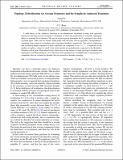| dc.contributor.author | Fu, Liang | |
| dc.contributor.author | Kane, C. L. | |
| dc.date.accessioned | 2013-02-21T14:10:28Z | |
| dc.date.available | 2013-02-21T14:10:28Z | |
| dc.date.issued | 2012-12 | |
| dc.date.submitted | 2012-08 | |
| dc.identifier.issn | 0031-9007 | |
| dc.identifier.issn | 1079-7114 | |
| dc.identifier.uri | http://hdl.handle.net/1721.1/77170 | |
| dc.description.abstract | A field theory of the Anderson transition in two-dimensional disordered systems with spin-orbit interactions and time-reversal symmetry is developed, in which the proliferation of vortexlike topological defects is essential for localization. The sign of vortex fugacity determines the Z[subscript 2] topological class of the localized phase. There are two distinct fixed points with the same critical exponents, corresponding to transitions from a metal to an insulator and a topological insulator, respectively. The critical conductivity and correlation length exponent of these transitions are computed in an N=1-ϵ expansion in the number of replicas, where for small ϵ the critical points are perturbatively connected to the Kosterlitz-Thouless critical point. Delocalized states, which arise at the surface of weak topological insulators and topological crystalline insulators, occur because vortex proliferation is forbidden due to the presence of symmetries that are violated by disorder, but are restored by disorder averaging. | en_US |
| dc.language.iso | en_US | |
| dc.publisher | American Physical Society | en_US |
| dc.relation.isversionof | http://dx.doi.org/10.1103/PhysRevLett.109.246605 | en_US |
| dc.rights | Article is made available in accordance with the publisher's policy and may be subject to US copyright law. Please refer to the publisher's site for terms of use. | en_US |
| dc.source | APS | en_US |
| dc.title | Topology, Delocalization via Average Symmetry and the Symplectic Anderson Transition | en_US |
| dc.type | Article | en_US |
| dc.identifier.citation | Fu, Liang, and C. L. Kane. “Topology, Delocalization via Average Symmetry and the Symplectic Anderson Transition.” Physical Review Letters 109.24 (2012). © 2012 American Physical Society | en_US |
| dc.contributor.department | Massachusetts Institute of Technology. Department of Physics | en_US |
| dc.contributor.mitauthor | Fu, Liang | |
| dc.relation.journal | Physical Review Letters | en_US |
| dc.eprint.version | Final published version | en_US |
| dc.type.uri | http://purl.org/eprint/type/JournalArticle | en_US |
| eprint.status | http://purl.org/eprint/status/PeerReviewed | en_US |
| dspace.orderedauthors | Fu, Liang; Kane, C. L. | en |
| dc.identifier.orcid | https://orcid.org/0000-0002-8803-1017 | |
| mit.license | PUBLISHER_POLICY | en_US |
| mit.metadata.status | Complete | |
